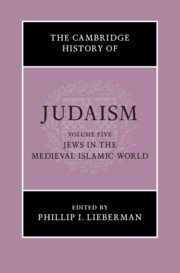Book contents
- The Cambridge History of Judaism
- The Cambridge History of Judaism
- The Cambridge History of Judaism
- Copyright page
- Contents
- Figures
- Acknowledgments
- Introduction
- Part I Jews in the Medieval Islamic World
- Part II Social and Institutional History
- Part III Spiritual and Intellectual History
- Chapter 17 Karaism
- Chapter 18 Non-Rabbinic and Non-Karaite Religious Movements
- Chapter 19 Languages and translation
- Chapter 20 Book Production
- Chapter 21 Jewish Bible Exegesis in Muslim Lands in the Middle Ages
- Chapter 22 Jewish Law
- Chapter 23 Liturgy
- Chapter 24 Piyyuṭ
- Chapter 25 Jewish Philosophy
- Chapter 26 Science and Medicine
- Chapter 27 Magic
- Chapter 28 Mysticism
- Chapter 29 Belles Lettres
- Chapter 30 Jewish-Muslim Polemics
- Chapter 31 Historiography
- Chapter 32 Material Culture, Art, and Architecture
- Index
- References
Chapter 19 - Languages and translation
from Part III - Spiritual and Intellectual History
Published online by Cambridge University Press: 21 August 2021
- The Cambridge History of Judaism
- The Cambridge History of Judaism
- The Cambridge History of Judaism
- Copyright page
- Contents
- Figures
- Acknowledgments
- Introduction
- Part I Jews in the Medieval Islamic World
- Part II Social and Institutional History
- Part III Spiritual and Intellectual History
- Chapter 17 Karaism
- Chapter 18 Non-Rabbinic and Non-Karaite Religious Movements
- Chapter 19 Languages and translation
- Chapter 20 Book Production
- Chapter 21 Jewish Bible Exegesis in Muslim Lands in the Middle Ages
- Chapter 22 Jewish Law
- Chapter 23 Liturgy
- Chapter 24 Piyyuṭ
- Chapter 25 Jewish Philosophy
- Chapter 26 Science and Medicine
- Chapter 27 Magic
- Chapter 28 Mysticism
- Chapter 29 Belles Lettres
- Chapter 30 Jewish-Muslim Polemics
- Chapter 31 Historiography
- Chapter 32 Material Culture, Art, and Architecture
- Index
- References
Summary
Jews living in the Islamic world during the medieval period had access to a great variety of languages and frequently used several, depending upon the social, cultural, religious, or economic context in which they operated at any given time. But as these languages came to be used within Jewish communities, they developed idiosyncrasies in relation to the particular religious culture in which they grew up and came to form variants that were clearly distinguished from the variety used in non-Jewish communities. While medieval Jews living in Islamic lands used standard varieties of their languages outside of the Jewish community, they also used specific Jewish varieties when communicating with their coreligionists. Over the years, scholars have debated whether there are enough reasons to use the term “Jewish languages” to describe the written and spoken variants used by members of Jewish communities. The purely linguistic arguments seem insufficient to some philologists to justify distinguishing different linguistic systems. These objections aside, the prevailing opinion is that from a sociolinguistic perspective, Jews often used a particular form of language (“sociolect,” “ethnolect,” or “religiolect”) in intra-communal contexts. And in fact, many linguists prefer to use the phrase “Jewish language continuum” to describe the relationship between Jewish languages and the majority-culture languages to which they relate; this terminology allows for scholarly analysis to consider both continuities and differences between Jewish and other varieties of languages. Hebrew is a language closely identified with the history and culture of the Jewish people, and it is often identified as “the language of Judaism,” although as we shall see below the reality is often more complex. In fact, it was far from being the main or only language of the Jews in the Middle Ages. There is no doubt that medieval Jews were at least bilingual and, in some cases, plurilingual, using their many languages to conduct varied activities in all areas of cultural and day-to-day life, and working between languages as translators, dragomans, and go-betweens.
- Type
- Chapter
- Information
- The Cambridge History of Judaism , pp. 634 - 665Publisher: Cambridge University PressPrint publication year: 2021



